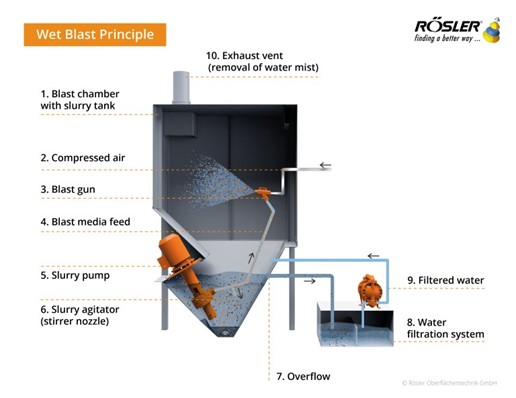
Wet Blasting Equipment & Media, Part 2 – Technical Components Combine for Systematic Success
, sramaker - Zurück zur Übersicht
Wet blasting technology lends itself to a variety of processes and industries. From applying cosmetic (anti-glare) finishes and surface smoothing to deburring, de-powdering, decontaminating, and cleaning after casting, welding, and additive manufacturing, wet blasting has many capabilities.
Rosler has decades of worldwide experience developing technology and machines customized to each customer’s unique challenges and demands. Each solution we deliver is innovatively designed around core wet blasting components and calibrated to your work piece with carefully selected media and tested process parameters.
Basics Components
Wet Blast Principle Diagram
Regardless of their uses, all Rosler wet blasting machines start with a core group of components. While customized options and accessories can be added, these systems typically include 10 key components.
- Blast chamber with slurry tank – A mix of media and water is stored in this holding tank found at the bottom of the blast chamber. The chamber is made of stainless steel.
- Compressed air – Approximately 70 PSI of compressed air accelerates the slurry.
- Blast gun(s) – One or more guns accelerate the slurry supplied by the slurry pump with compressed air.
- Blast media feed – This component supplies the media slurry to the blast nozzle.
- Slurry pump – This high-powered mechanism transports the slurry to the blast gun(s). Larger wet blast systems can be equipped with multiple pumps.
- Slurry agitator (stirrer nozzle) – In order to keep the media suspended in the water, the slurry pump diverts some of its flow to a stirrer nozzle placed in the tank to agitate the mix of water and abrasives.
- Overflow – Small media particles, dirt, and other contaminants tend to stay suspended and are skimmed off and sent to the filtration unit.
- Water filtration system – Media particles and debris skimmed off the water’s surface must be passed through a filtration system to separate still usable media and process water from waste. Common filtration methods include hydrocyclones, weir tanks, bag filters, paper band filters, and semi- and fully automatic centrifuges.
- Filtered water – Once processed by a water filtration system, water is returned to the slurry tank and reused.
- Exhaust vent – The water mist mixed with media fines and other small particulates is removed from blast cabinet by suction fan-equipped filters.
The Rosler Way
We have the experience and expertise to meet your wet blasting needs. Rosler partners with you to find a better way, the best machine, and the best finishing results. Contact us today to discuss your unique challenges.
Previous posts in the Wet Blasting Equipment & Media series include:
- Part 1 – “Machines Range in Complexity, Uses.”
- Part 2 – “Technical Components Combine for Systematic Success.”
- Part 3 – “Maintain Slurry Concentrations for Finishing Consistency.”
Upcoming posts will include:
- Part 4 – “Internal Cleaning, Rebuilds Prolong Machine Lifetime.”
- Part 5 – “Careful Media Selection, Additive Use Impact Results.”
Sign up for enews alerts to be notified of new posts!
